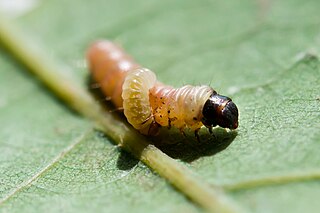Rhopalosetia is a monotypic moth genus in the family Copromorphidae. Its only species, Rhopalosetia phlyctaenopa, is found in French Guiana. Both the genus and species were first described by Edward Meyrick in 1926.

Psilocorsis is a genus of moths of the family Depressariidae.
Psilocorsis purpurascens is a moth in the family Depressariidae. It was described by Walsingham in 1912. It is found in Guatemala.
Machimia cruda is a moth in the family Depressariidae. It was described by Edward Meyrick in 1926. It is found in Colombia.
Psilocorsis melanophthalma is a moth in the family Depressariidae. It was described by Edward Meyrick in 1928. It is found in Colombia.
Psilocorsis minerva is a moth in the family Depressariidae. It was described by Edward Meyrick in 1928. It is found in Colombia.
Brachmia superans is a moth in the family Gelechiidae. It was described by Edward Meyrick in 1926. It is found in north-eastern India.
Dichomeris indiserta is a moth in the family Gelechiidae. It was described by Edward Meyrick in 1926. It is found in Malaysia.
Dichomeris antisticha is a moth in the family Gelechiidae. It was described by Edward Meyrick in 1926. It is found in Costa Rica.
Dichomeris physocoma is a moth in the family Gelechiidae. It was described by Edward Meyrick in 1926. It is found in Sierra Leone.
Dichomeris syndyas is a moth in the family Gelechiidae. It was described by Edward Meyrick in 1926. It is found in Asia Minor.
Dichomeris semnias is a moth in the family Gelechiidae. It was described by Edward Meyrick in 1926. It is found in north-eastern India.
Dichomeris exallacta is a moth in the family Gelechiidae. It was described by Edward Meyrick in 1926. It is found in Peru.
Dichomeris syringota is a moth in the family Gelechiidae. It was described by Edward Meyrick in 1926. It is found in Peru.
Dichomeris acratopa is a moth in the family Gelechiidae. It was described by Edward Meyrick in 1926. It is found in Cameroon.
Hypatima haligramma is a moth in the family Gelechiidae. It was described by Edward Meyrick in 1926. It is found in southern India and Thailand.
Hypatima lecticata is a moth in the family Gelechiidae. It was described by Edward Meyrick in 1926. It is found in Mpumalanga, South Africa.
Hypatima meliptila is a moth in the family Gelechiidae. It was described by Edward Meyrick in 1926. It is found in Papua New Guinea, where it has been recorded from New Ireland.
Hypatima nimbigera is a moth in the family Gelechiidae. It was described by Edward Meyrick in 1926. It is found in Papua New Guinea, where it has been recorded from New Ireland.
Anarsia melanchropa is a moth in the family Gelechiidae. It was described by Edward Meyrick in 1926. It is found in north-western India.
